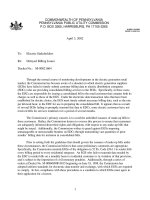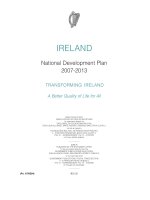National Broadband Plan Presentation Commission Meeting Slides pptx
Bạn đang xem bản rút gọn của tài liệu. Xem và tải ngay bản đầy đủ của tài liệu tại đây (342.22 KB, 35 trang )
National Broadband Plan
Policy Framework
December 16, 2009 – FCC Open Meeting
63 days until Plan is due
2
What we want to accomplish today
•
Review principles for policy development
• Review framework for National Broadband Plan
3
Congressional mandate
• Advancing consumer welfare
• Civic participation
• Public safety and homeland security
• Community development
• Health care delivery
• Energy independence and efficiency
• Education
• Worker training
• Private sector investment
• Entrepreneurial activity
• Job creation and economic growth
• Other national purposes
To fulfill statutory obligation to write a plan that will “seek to ensure that all people of the
United States have access to broadband capability and shall establish benchmarks for
meeting that goal.”
Other Statutory Objectives:
(A) Analyze the most effective and efficient mechanisms for ensuring broadband access by
all people of the United States
(B) Provide:
- A detailed strategy for achieving affordability of such service.
- A detailed strategy for maximum utilization of broadband infrastructure and service
by the public
(C) Evaluate the state of deployment
- Include an evaluation of progress of projects supported by the grants made pursuant
to the Recovery Act
(D) Provide a plan for the use of broadband infrastructure and services in:
4
Guiding principles for Plan development
1. Open and transparent process
2. Build on specific attributes of American broadband ecosystem
3. Aspire high, but find a practical and sustainable path
4. Recommend concrete action based on data and analysis
5. Eye on the future
5
Guiding principles for policy choices
1. Private sector investment is essential; new funding is limited
2. Competition drives innovation and better choices for consumers
3. Better utilization of existing assets is required
4. Policy changes require consideration of unintended consequences
5. New law is necessary in certain cases, but should be limited
6
Plan will accelerate innovation and investment across the
broadband ecosystem
Adoption &
Utilization
Network
Services
Devices
Applications &
Content
Fixed and
mobile
Consumers,
business,
government
7
Overview and proposed framework to address key gaps
Network
Devices
Gaps and Issues Framework
•
Fixed
infrastructure
availability gap
1. Transform USF to support broadband
•
Reform existing programs through short term actions
•
Engage in rule changes for longer term transformation
•
Middle mile gap 2. BTOP provides middle mile funding in current tranche
•
Consider future mechanisms to fill remaining gaps
•
ROW and pole
attachments gap
3. Improve infrastructure access
•
Reform ROW, poles, and conduit to reduce deployment costs
•
Enable municipal efforts where appropriate
4. Incentives for capital formation, investment
•
Tax Policy
•
Competition
•
Consider incentives for certain geographies, such as tribal
lands
• Spectrum gap 5. 21st century spectrum policy
•
Long term, not ad hoc, process for spectrum
•
More bandwidth for broadband
•
Enable innovative opportunistic new uses for spectrum
• Data gap 6. Improved data collection across the Commission
• Set top boxes 7. Transform CableCard to enable video and IP convergence
and greater device innovation
8
Applications
and Content
Adoption and
Utilization
Gaps and Issues Framework
•
Consumer
information gap
8. Broadband Transparency Initiative to enable more
educated choices
•
End user data control
gap
9. Enable innovative uses in secure, privacy-protected,
environment
•
Media gap 10. Incentives for institutions to fill emerging gaps in
news and information
•
Cybersecurity and
piracy gaps
11. Ensure a safe, secure Internet that respects
intellectual property laws
•
Adoption and
utilization gap
12. BTOP Sustainable Adoption Funding
13. National support for local, targeted efforts,
including standard-setting and clearinghouse
14. Digital literacy efforts
• Affordability gap 15. BTOP Public Computing Center Program
16. USF support for low-income broadband adoption
• Accessibility gap 17. Emphasis on specific situations such as Americans
with disabilities
Overview and proposed framework to address key gaps
9
Areas of Focus for Today
•
USF
•
Infrastructure access
•
Spectrum
•
Tribal lands
•
Set-top boxes
• Consumer information
•
Media
•
Adoption
•
Accessibility
•
Public safety (Other national purposes in January)
10
USF Reform Guiding Principles
1. Universality is the focus on availability and affordability
2. USF resources are finite; require allocation tradeoffs
3. USF policies should be viewed holistically across all four USF
support programs
4. USF policies should be flexible enough to adjust to changes in
technology and demand for broadband services
5. USF policies should be designed to achieve measurable
outcomes with transparency, oversight, and accountability
6. USF reforms should have a predictable and defined transition
path
11
USF Short and Medium Term Action
Framework: What are short-term actions to improve performance of
current system? Options under consideration include:
- Cutting inefficient spending in the high cost fund
-
Removing barriers to use of E-Rate funded connections in schools for
adoption and community use comparable to permissible uses of E-
Rate funded connections in libraries
-
Enabling schools and libraries that currently have dial-up to migrate
to broadband
-
Extending the deadline for the Rural Health Care Pilot Program and
providing more administrative support to help participants through
the process
Network
12
USF Long Term Transformation
Framework: What can be done to transform USF to shift the focus to
support for broadband services? Options under consideration include:
-
Revising the current method of collecting funds with an emphasis on
sustainability
-
Transforming the High Cost Fund to support specific broadband goals
over the next 5 to 10 years with a defined transition path for existing
recipients
-
Permitting low income households to use Lifeline support for broadband;
integrating Lifeline with other programs to promote adoption and digital
literacy
-
Based on lessons learned from the Rural Health Care Pilot Program,
designing a new health program to expand affordable broadband
connectivity
- Considering USF reform in conjunction with other FCC proceedings such
as ICC and Special Access
Network
13
Infrastructure Access Guiding Principles
1. Broadband infrastructure requires a partnership between the
federal government and various state and local entities
2. Timely and predictable dispute resolution is critical to private
investment in deployment
3. Federal investments in roads, bridges, and other infrastructure
provide an opportunity to deploy broadband infrastructure
4. Lowering the costs of infrastructure inputs improves the business
case for further upgrades and sustainable competition
5. Better coordination can reduce costs throughout the entire
ecosystem – “dig once”
Network
14
Infrastructure Initiatives
Framework: The Plan should explore reducing cost of ROW and pole
attachments and, in certain circumstances, improving options for
municipalities, both of which would help drive more deployment. Options
under consideration include:
- Establish a uniform and fair rental rate for pole attachments
-
Adopt rules that lower make-ready costs and speed access to poles,
ducts, conduits, and Rights of Way
-
Create a streamlined dispute resolution mechanism
-
Enable municipalities to create broadband options where circumstances
warrant
-
Amend section 224 to establish a consistent national framework for all
poles, ducts, and conduits
Network
15
Spectrum Policy Guiding Principles
1. The demand for wireless broadband services will exceed the supply of
spectrum to deliver those services
2. There is not enough new spectrum for wireless broadband services in
the pipeline to close this gap
3. It takes a long time to address spectrum gaps, so we must start now
4. There are 3 potential paths to close the gap. We must pursue all 3 –
each individually is necessary but not sufficient
a. More productive use of existing bands
b. More bandwidth available for broadband services
c. Development & deployment of technologies to support new uses
5. A large, new spectrum allocation is essential to improving broadband
competition
6. The country should review spectrum allocations & management
practices periodically going forward to ensure the most productive use
of this national asset
7. An RF assessment is a key enabler for periodic spectrum reviews
8. Market forces should be applied to all bands, though other policy
objectives should play a role in allocation decisions
Network
16
Long-Term Planning; More Efficient Use
Framework: What can be done to provide better transparency and better
incentives to encourage incumbents to use existing allocations more
effectively? Options under consideration include:
-
An RF assessment tool to document and expose current license and
usage information to facilitate research, planning, and potential
transactions
-
A periodic spectrum review process which is based on a list of factors
that the FCC and NTIA can use to determine actions with regard to
particular bands
- Utilization of spectrum fees and band-clearing auctions to drive more
effective market allocation
-
Greater incentives for more efficient use of government spectrum
Network
17
More Bandwidth for Broadband
Framework: Consider all options for spectrum to close the gap and secure an innovative wireless industry, balancing the engineering and policy constraints
present in the current allocations. Options under consideration include:
-
Identify new spectrum for licensed and unlicensed use
-
Resolve pending spectrum allocation & use issues, including:
-
Advanced Wireless Services 2 & 3
-
Wireless Communications Service viability for mobile service
-
700 MHz D Block
-
TV White Spaces
-
Explore various proposals that have been submitted, including:
-
Access to TV spectrum while maintaining over-the-air television
-
Access to federal spectrum in conjunction with NTIA
-
Use of terrestrial operations in mobile satellite spectrum
Network
18
Enable Innovative Uses
Framework: Spectrum is a key ingredient to a technology sector, requiring
space for unlicensed and opportunistic use to promote new devices and
applications. Options under consideration include:
-
Preserving spectrum for unlicensed devices
-
Developing tools to manage access in order to protect incumbent
operators
-
Allowing opportunistic use on FCC-held licenses (i.e., licenses not sold
at auction)
-
Enabling spectrum monitoring equipment to better inform the
availability of spectrum including on a real time database
- Expanding model of opportunistic use to other bands where
appropriate
-
Creating an interference dispute resolution mechanism
Network
19
Set Top Box Guiding Principles
1. Increasingly, the television is becoming an Internet-access
device
2. Delivering Internet video to the television could drive higher
broadband adoption and utilization (as 99% of households have
TVs, versus 79% with computers) as new apps and uses would
emerge
3. The convergence of television and the Internet is hindered by the
lack of innovation in the set top box market
4. An open market in devices will drive further innovation
5. To date, CableCARD has not achieved its intended goals, in part
due to poor implementation
6. The FCC has the authority to help open the set top box market to
greater competition and innovation
Devices
20
Set Top Boxes
Framework: How can the FCC ensure the competitive availability of video
navigation devices (e.g., STBs, TVs, DVRs) pursuant to 47 U.S.C. § 549
to foster greater device innovation in the set top box market and the
convergence of Internet and television? Options under consideration
include:
-
Fix CableCARD: directly address current barriers to implementation
of CableCARD; including bundled provisioning, pricing, and billing
-
Mandate a home gateway device. Require MVPDs to provide a
small, low-cost device whose only functionality is to bridge the
proprietary MVPD network elements (conditional access, tuning &
reception functions) to common, open standard widely-used in home
communications interfaces; enables a retail navigation device to
operate on all MVPD platforms
Devices
21
The Future of Media
• Universal broadband important to ensuring that the new media
landscape benefits all Americans
•
The spread of Internet access:
-
Undermined established media business models
- Triggered an explosion of innovation in the media space
•
The Broadband Plan will assess the impacts of the universal
broadband strategy both on commercial media and the public
media licensees
Applications
and Content
22
Broadband Transparency Guiding Principles
1. Consumers should understand the actual performance of the
products and services they purchase
2. A market of better informed consumers will foster competition
and encourage providers to deliver improving service
3. The information provided consumers should be clear, simple, and
verifiable
4. There is a considerable difference between advertised “up to”
and “actual” performance
5. There are a number of factors that determine network
performance
6. Service providers cannot control every aspect of network
performance (e.g., end-user hardware)
Applications
and Content
23
Broadband Transparency Initiative
Framework: Consumers should have better information about actual
performance of different services to incent competition and improved
performance. Options under consideration include:
-
A measurement system that allows consumers to see the difference
between average and advertised speeds
-
A speedtest application that leverages speedtests available in the
market so that consumers and the FCC can develop a more complete
view of fixed network performance as experienced by users
-
A ratings system so consumers or property owners can see the relative
performance of broadband in their facility
-
In partnership with NTIA, a National Broadband Map that provides a
clearinghouse of broadband data that is searchable, and open to direct
consumer feedback on their connection and options available in their
local area
Applications
and Content
24
Tribal Lands Guiding Principles
1. Native American tribes are sovereign governments with distinct
political and Tribal structures
2. As such, tribes have a special relationship with the federal
government based on the premise of government-to-government
interaction
3. Both deployment and adoption of broadband on Tribal lands is
dramatically worse than elsewhere in the US
4. Tribal lands tend to be more rural and remote than other regions
of the country, and thus more costly to serve
5. Each Tribal situation is unique
Tribal Lands
25
Tribal Lands
Framework: Recommendations for Tribal lands in the broadband plan
should address future data gathering, deployment, adoption, national
purposes and coordination/governance topics. Options under
consideration include:
-
Tribal-specific data gathering effort for both deployment and
adoption
-
Deployment to key “anchor institutions” in Tribal lands as a way to
reach broader population
-
Continuing to facilitate Tribal participation in USF
-
Coordinating with other Plan recommendations that intersect with
Tribal issues (e.g., education, health care)
- Creating a joint Federal-Tribal broadband working group to identify
ways to remove barriers to deployment and adoption on Tribal lands
Tribal Lands









